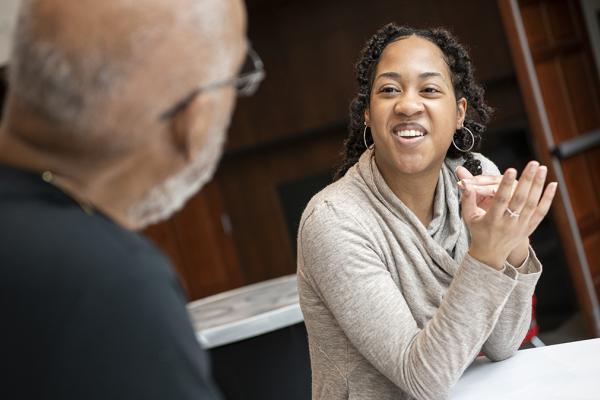60 Years apart, scientists share zeal for discovery

|
Kristin Chesnutt, a third-year graduate student in biochemistry, is the first recipient of the Nancy Byrd Johnson and Howard M. Johnson endowment. Her dissertation focuses on how chromatin, a substance within a chromosome consisting of DNA and protein, is packaged into our cells. She is currently working in the lab of Michael Poirier, chair and professor in the Department of Physics. Two Buckeyes, separated in age by 61 years, are deep in conversation about biochemistry. Their eyes are locked, heads nodding as their talk about nucleosomes, a basic structural unit of chromosomes, turns to the retired scientist’s past research. “Regular membrane signaling is basically the same as steroid receptor signaling,” says Howard M. Johnson ’58, ’59 MS, ’62 PhD. “You take those things and you can find all the players at the promoters and even at the enhancers.” “Oh, wow. OK. Yeah. I’ve never thought about it from that perspective,” says Kristin Chesnutt, a third-year graduate student in biochemistry. Chesnutt, 25, shares the same joy in discovery that propelled Johnson’s groundbreaking research as a microbiologist and immunologist. She’s a kindred spirit and the first recipient of the Nancy Byrd Johnson and Howard M. Johnson endowment. Originally, Chesnutt considered medical school. A summer research internship while an undergrad in molecular biology at East Carolina University shifted her focus to science. “I love being able to collaborate with others in a lab,” Chesnutt says. “I like working as part of a team to figure out answers to questions, solve problems and strive for that one goal.” At Ohio State, Chesnutt is working in the lab of Michael Poirier, chair and professor in the Department of Physics, with about a dozen other graduate students and postdocs. Her dissertation focuses on how chromatin, a substance within a chromosome consisting of DNA and protein, is packaged into our bodies’ cells. Chesnutt’s research has her in the lab at least five days a week, often until late at night, and sometimes weekends. “It’s a lot of thinking — the most thinking I’ve ever done in my life,” she says. “In graduate school, you already have set pay, and I work so much in the lab that I don’t have time to get a job on the side. This endowment means I’m able to just focus on my research and the science.” Chesnutt says she’s amazed that Johnson, who came to Ohio State as an undergraduate student in 1954, is helping her move forward in science nearly seven decades later. “Dr. Johnson is definitely someone to look up to. What you see really does impact what you think you can do. When you’re younger and looking at your different options, if you see a Black person who is a scientist, you think, Maybe this is something I can do. “It’s very inspiring,” she says. “It makes you think about all the ways you can give back as well.” -Author, Todd Jones, Ohio State Alumni Magazine
Kristin adds, “I am thrilled to be investigating how two coactivator complexes, SAGA and ATAC, differentially target and regulate chromatin dynamics, and the implications for transcription regulation.”
|
